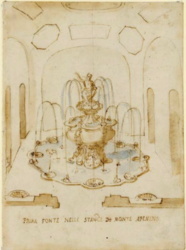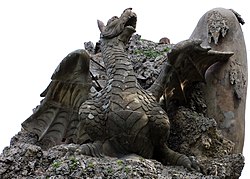Apennine Colossus
| Apennine Colossus | |
|---|---|
| Italian:Colosso dell'Appennino | |
 Colossus of Apennine | |
 | |
| Artist | Jean de Boulogne,a.k.a.Giambologna |
| Completion date | late 1580s |
| Medium | Stone |
| Dimensions | 11 meters (36 feet) |
| Location | Vaglia,Italy |
| 43°51′34.1″N11°18′16.4″E/ 43.859472°N 11.304556°E | |
TheApennine Colossus(Italian:Colosso dell'Appennino) is a stone statue, approximately 11 meters high,[1]in the estate of theVilla DemidoffinVaglia,Tuscany,Italy.Giambologna(Flemishsculptor Jean de Boulogne) created the colossal figure, a personification of theApennine mountains,in the late 1580s. It was constructed on the grounds of theVilla di Pratolino,aRenaissancevilla that fell into disrepair and was replaced by the Villa Demidoff in the 1800s.[2]
Description
[edit]The colossus is about 11 metres (36 ft) high[1]and is meant as a personification of theApennine Mountains.[3][4]It was the water source for the Pratolino,[5]its fountains and secret water plays.[6]The colossus has the appearance of an elderly man crouched at the shore of a lake[7]and is surrounded by other sculptures depicting mythological themes fromOvid'sMetamorphosesincludingPegasus,ParnassusorJupiter.[8]It is presumed that Giambologna was inspired by the description of a mountain-likeAtlasin Ovid's Metamorphoses, when he designed the figure of Apennine.[8]Other sources cite the Atlas as described in theAeneidof the Roman poetVirgilas an inspiration.[9]With his left hand in front of him, the Apennine seems to squeeze the head of a sea monster[7]through whose open mouth water emanates into the pond ahead of the statue.[10]The stone colossus is depicted naked, withstalactitesin the thick beard[10]and long hair to show themetamorphosisof man and mountain, blending his body with the surrounding nature, populated by aquatic vegetation.[11]The statue is described to originally have been emerging from its environment[12]like being alive. The giant was able to sweat and weep over a network of water pipes.[5]In the winter season,icicleswould cover his body.[5]The work was made of stone and plaster and appearing to be partially covered with moss and lichens.[11]
Within the giant exist a series of chambers and caves on three levels.[5]In the ground floor of the colossus exists a cave[13]containing an octagonal fountain dedicated to the Greek goddessThetys.[14]The Italian painterJacopo Ligozziadorned the Grotto de Thetys[15]with frescos of villages from the Mediterranean coast of Tuscany in 1586.[16]In other chambers mining scenes based on the bookDe re metallicaby the mineralogistGeorgius Agricolawere to be seen.[17]In the giant's upper floor is a chamber big enough for a small orchestra and in the head a small chamber holds a fireplace out of which the smoke would escape through his nostrils.[10]The chamber in the head had slits in the ears and the eyes.[7]Francesco I de Medici,Grand Duke of Tuscany, enjoyed fishing while sitting in the head chamber, throwing thefishing linethrough one of the eye slits.[5]At night the chamber was illuminated with torches, following which the eyes appeared to glow in the dark.[5]Initially, the back of the Colossus was protected by a structure resembling a cave, as seen on an etching byStefano della Bella.[18][14]As Giambologna was an admirer of the Italian sculptorMichelangelothe cave-like structure was also compared with Michelangelo's style of thenon-finito.[4]On top of it, there was a terrace.[5]The cave-resembling structure was demolished around 1690 by the sculptorGiovan Battista Foggini,who also built a statue of a dragon[19]to adorn the back of the colossus.[5]The dragon was described to have been a fountain, but it is assumed the dragon's belly was transformed into a fireplace while the dragon's neck and head had the function of its chimney.[20]In 1876, the Italian sculptorRinaldo Barbettirenovated the statue.[21]
Location and ownership
[edit]The Pratolino is located about 10 kilometres (6.2 mi) north ofFlorenceat the foot of the Apennine mountain range.[22]In it, there is a rectangular square called the Prato del Appennino, situated in front of the colossus.[14]
After Francesco de' Medici's death in 1587 and that of his wifeBianca Capellothe next day,[23]the villa and its surroundings fell into decay.[11]The Villa di Pratolino was demolished in 1822[11]and in 1872, the heirs ofLeopold II, Grand Duke of Tuscany,sold the estate[12]to theDemidoff familywho built their own villa on it.[7]In 1981, the Villa Demidoff was purchased by theProvince of Florence[24]and today the park and its giant are accessible to the public.[12]
Gallery
[edit]-
Etching byStefano Della Bella
-
Fountain of Thetys in the ground floor byGiovanni Guerra
-
Upper chamber within the statue
-
Dragon at the back of the Colossus byGiovanni Battista Foggini
References
[edit]- ^abMorgan, Luke (2015), p.12
- ^Smith, Webster (1 December 1961)."Pratolino".Journal of the Society of Architectural Historians.20(4):155–168.doi:10.2307/988039.ISSN0037-9808.JSTOR988039.
- ^Morgan, Luke (2015)."The Monster in the Garden | Luke Morgan".www.upenn.edu.p. 3.Retrieved16 January2022.
- ^abMöseneder, Karl (1985)."Werke Michelangelos als Movens ikonographischer Erfindung".Mitteilungen des Kunsthistorischen Institutes in Florenz.29(2/3):352–353.ISSN0342-1201.JSTOR27653166.
- ^abcdefghSteadman, Philip (2021)."The 'garden of marvels' at Pratolino".Renaissance Fun.The machines behind the scenes. UCL Press. p. 290.doi:10.2307/j.ctv18msqmt.16.ISBN978-1-78735-916-1.JSTORj.ctv18msqmt.16.S2CID241909486.Retrieved15 January2022.
- ^Steadman, Philip (2021), pp. 286–287
- ^abcdRubboli, Matteo (3 February 2020)."Il Colosso dell'Appennino: la Gigantesca Statua Dimenticata alle Porte di Firenze".Vanilla Magazine(in Italian).Retrieved13 January2022.
- ^abHunt, John Dixon (15 February 2016).Garden and Grove: The Italian Renaissance Garden in the English Imagination, 1600–1750.University of Pennsylvania Press. p. 55.ISBN978-0-8122-9278-7.
- ^Morgan, Luke (2015) p. 9
- ^abcIlya (11 May 2013)."The Appennine Colossus".Unusual Places.Retrieved13 January2022.
- ^abcdRicupati, Daniela (10 November 2021)."Il Colosso dell'Appennino di Giambologna".Il Giardino della Cultura(in Italian).Retrieved13 January2022.
- ^abc"Gardens in Tuscany | Villa di Pratolino | Parco Villa Demidoff".www.travelingintuscany.com.Retrieved13 January2022.
- ^Steadman, Philip (2021), p. 291
- ^abcSmith, Webster (1961)."Pratolino".Journal of the Society of Architectural Historians.20(4): 156.doi:10.2307/988039.ISSN0037-9808.JSTOR988039.
- ^Tantardini, Lucia; Norris, Rebecca (2020).Lomazzo's Aesthetic Principles Reflected in the Art of his Time: With a Foreword by Paolo Roberto Ciardi, an Introduction by Jean Julia Chai, and an Afterword by Alexander Marr.Brill.p. 17.ISBN978-90-04-43510-0.
- ^Hirschboeck, Martin (2014)."Jacopo Ligozzi, An allegory of virtue"(PDF).p. 29.Retrieved15 January2022.
- ^Steadman, Philip (2021) pp.293–294
- ^Massar, Phyllis D. (1968)."Presenting Stefano della Bella".The Metropolitan Museum of Art Bulletin.27(3): 174.doi:10.2307/3258383.ISSN0026-1521.JSTOR3258383.
- ^"Rilievo e modellazione del Gigante dell'Appennino nel parco di Pratolino | geomaticaeconservazione.it".www.geomaticaeconservazione.it.Archived fromthe originalon 16 January 2022.Retrieved16 January2022.
- ^Steadman, Philip (2021), pp. 290–291
- ^"Barbetti Rinaldo".Recta Galleria d'arte – Roma(in Italian).Retrieved13 January2022.
- ^Steadman, Philip (2021), p. 279
- ^Steadman, Philip (2021), p. 315
- ^"Russi in Italia: dizionario - Russi in Italia".www.russinitalia.it.Retrieved13 January2022.
External links
[edit] Media related toAppennino by Giambolognaat Wikimedia Commons
Media related toAppennino by Giambolognaat Wikimedia Commons





